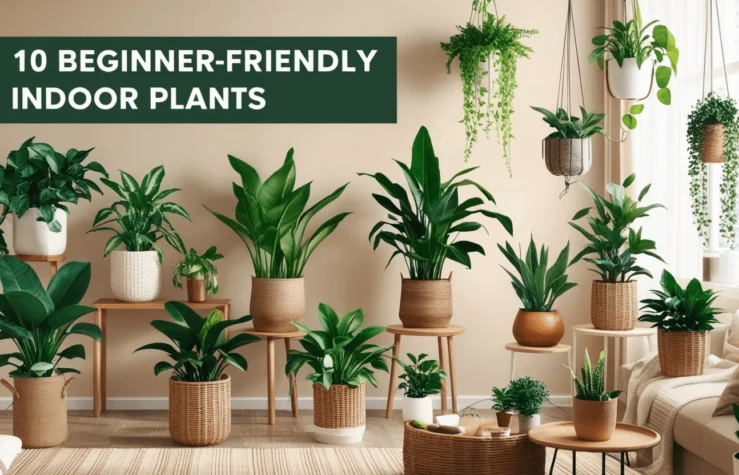Starting with indoor plants can be a rewarding experience, especially if you choose varieties that are easy to care for. The following are a few of the top beginner friendly indoor plants:

- Snake Plant (Sansevieria)
Care Requirements: The Snake Plant is one of the most forgiving indoor plants, making it perfect for beginners. It can thrive in various light conditions, from low to bright indirect light, and is highly tolerant of infrequent watering. It’s ideal for those who might forget to water their plants occasionally. Overwatering can lead to root rot, so it’s best to let the soil dry out between waterings.
Benefits: This plant is not only hardy but also an excellent air purifier. It removes toxins such as formaldehyde, benzene, and xylene from the air. Additionally, it’s known for its ability to convert carbon dioxide into oxygen even at night, making it a great choice for bedrooms. - Spider Plant (Chlorophytum comosum)
Care Requirements: Spider Plants are incredibly adaptable and thrive in indirect light, making them suitable for various indoor environments. They prefer to be kept slightly moist but can tolerate occasional overwatering. This plant is easy to propagate, producing “baby” plants (pups) that can be easily replanted.
Benefits: Spider Plants are known for their air-purifying capabilities, particularly in removing carbon monoxide and other impurities. They’re a safe option for houses with pets because they’re also non-toxic to them.

- Pothos (Epipremnum aureum)
Care Requirements: Pothos is also known as Money plant. It can grow in low light conditions, though it prefers bright, indirect light. It’s drought-tolerant, so it doesn’t require frequent watering—once the soil is dry, it’s time to water. It can be grown in water as well, making it versatile in how you display it.
Benefits: This plant is great for hanging baskets or as a trailing plant on shelves. Pothos is also effective at removing indoor pollutants like formaldehyde and benzene. Its lush, green leaves add a vibrant touch to any space. - Peace Lily (Spathiphyllum)
Care Requirements: Peace Lilies prefer low to medium light, making them ideal for indoor spaces without much natural sunlight. They like their soil to be kept slightly moist but not soggy. This plant will droop when it needs water, making it easy to know when to water it.
Benefits: The Peace Lily is well-known for its striking white blooms and glossy green leaves. Beyond its aesthetic appeal, it’s also a powerful air purifier, particularly effective at removing mold spores from the air. Because of this, it’s a great option for raising indoor air quality.

- ZZ Plant (Zamioculcas zamiifolia)
Care Requirements: The ZZ Plant is nearly indestructible, tolerating low light, neglect, and infrequent watering. It’s one of the best choices for beginners who are new to plant care. It prefers to be kept on the drier side, so it’s essential not to overwater.
Benefits: With its shiny, waxy leaves and upright growth, the ZZ Plant adds a bold, modern look to any room. It’s also an efficient air purifier, helping to remove toxins like xylene and toluene from the environment. - Aloe Vera
Care Requirements: Aloe Vera is a succulent, so it thrives in bright, indirect light and requires minimal watering. To avoid rot in the roots, the soil must be let to totally dry out in between waterings. It’s well-suited for sunny windowsills or spots with plenty of indirect sunlight.
Benefits: Besides being a beautiful addition to your home, Aloe Vera is known for its medicinal properties. The gel inside its leaves can be used to soothe burns, cuts, and other skin irritations, making it a practical and attractive houseplant.

- Succulents
Care Requirements: Succulents are ideal for beginners due to their low water needs and preference for bright light. These plants are adapted to arid environments, so they require very little water—watering once every few weeks is often sufficient.
Benefits: Succulents come in a wide variety of shapes, sizes, and colors, making them perfect for creating a unique indoor garden. They are drought-tolerant and can add a touch of greenery to small spaces or decorative arrangements. - Philodendron
Care Requirements: Philodendrons are versatile and easy to care for, thriving in both low and bright indirect light. They’re relatively drought-tolerant, so they can handle occasional missed waterings. Regular pruning can help control their growth and keep them looking full and lush.
Benefits: Available in both climbing and non-climbing varieties, Philodendrons are highly decorative and can be used as hanging plants or table plants. They’re also known for their ability to remove toxins from the air, contributing to a healthier indoor environment.

- Chinese Evergreen (Aglaonema)
Care Requirements: Chinese Evergreens are highly adaptable and can thrive in low to medium light conditions. They prefer to be watered moderately, allowing the soil to dry out between waterings. These plants are relatively slow growing, which means they don’t require frequent repotting.
Benefits: Known for their striking variegated leaves, Chinese Evergreens add a pop of color and pattern to indoor spaces. They’re also recognized for their air-purifying properties, particularly in removing harmful chemicals from the air. - Dracaena
Care Requirements: Dracaenas are easy to care for and do well in indirect light. They need to be watered when the top inch of soil becomes dry, and they love soil that drains well. These plants are relatively low-maintenance and can adapt to various indoor conditions.
Benefits: Dracaenas come in various forms, from tall, tree-like varieties to more compact options, making them versatile for different spaces. They’re also effective at filtering indoor air pollutants, making them a great addition to any home.
These indoor plants are not only beautiful but also resilient, making them perfect for beginners. With a little care, they can thrive and bring a touch of nature into your home.





